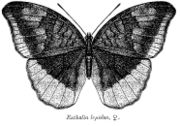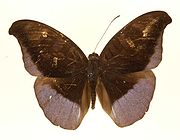
Tanaecia lepidea
Encyclopedia
The Grey Count is a species of nymphalid
butterfly
found in South
and Southeast Asia
.
 Upperside dark brown, paler in the female, with very obscure black markings of transverse lines across the cells of both fore and hind wings and an oblique discal fascia on the fore wing; an ash-grey continuous band along the termen of both fore and hind wings, gradually broadening from the apex of the fore, where it is very narrow, to the tornus of the hind wing, where it covers about one-third oil the wing. In the female this band is outwardly narrowly bordered with brown. Cilia white. Antennae, head, thorax and abdomen dark brown above; beneath, the antennae ochraceous, the rest dusky white washed with ochraceous. Underside: Male ochraceous brown, female bright ochraeeous. In both sexes the colours paler on the hind wing; the fore wing somewhat narrowly, the hind wing much more broadly suffused with lilacine-grey on the terminal margins and along the dorsal margin of the hind wing; cells of both wings with dark brown sinuous transverse lines and looplike markings ; both fore and hind wings crossed by somewhat diffuse broad discal and narrower postdiscal dark bands, prominent on the fore, obscure on the hind wing. Male with a patch of specialized dark scales above vein 4 on the upperside of the hind wing.
Upperside dark brown, paler in the female, with very obscure black markings of transverse lines across the cells of both fore and hind wings and an oblique discal fascia on the fore wing; an ash-grey continuous band along the termen of both fore and hind wings, gradually broadening from the apex of the fore, where it is very narrow, to the tornus of the hind wing, where it covers about one-third oil the wing. In the female this band is outwardly narrowly bordered with brown. Cilia white. Antennae, head, thorax and abdomen dark brown above; beneath, the antennae ochraceous, the rest dusky white washed with ochraceous. Underside: Male ochraceous brown, female bright ochraeeous. In both sexes the colours paler on the hind wing; the fore wing somewhat narrowly, the hind wing much more broadly suffused with lilacine-grey on the terminal margins and along the dorsal margin of the hind wing; cells of both wings with dark brown sinuous transverse lines and looplike markings ; both fore and hind wings crossed by somewhat diffuse broad discal and narrower postdiscal dark bands, prominent on the fore, obscure on the hind wing. Male with a patch of specialized dark scales above vein 4 on the upperside of the hind wing.

, central India, Orissa, Bengal and into Assam and the Malay Peninsula. Found in forested habitats.
Pupa. "More narrowed at the head than E. garuda, green, all the points golden tipped with black, and a few large spots of gold between." (Davidson & Aitken)
Food-plants include Melastoma malabatharicum, Planchonia careya
.
Nymphalidae
The Nymphalidae is a family of about 5,000 species of butterflies which are distributed throughout most of the world. These are usually medium sized to large butterflies. Most species have a reduced pair of forelegs and many hold their colourful wings flat when resting. They are also called...
butterfly
Butterfly
A butterfly is a mainly day-flying insect of the order Lepidoptera, which includes the butterflies and moths. Like other holometabolous insects, the butterfly's life cycle consists of four parts: egg, larva, pupa and adult. Most species are diurnal. Butterflies have large, often brightly coloured...
found in South
South Asia
South Asia, also known as Southern Asia, is the southern region of the Asian continent, which comprises the sub-Himalayan countries and, for some authorities , also includes the adjoining countries to the west and the east...
and Southeast Asia
Southeast Asia
Southeast Asia, South-East Asia, South East Asia or Southeastern Asia is a subregion of Asia, consisting of the countries that are geographically south of China, east of India, west of New Guinea and north of Australia. The region lies on the intersection of geological plates, with heavy seismic...
.
Description


Distribution
Found in the lower Himalayas eastwards from Almora. In the Western GhatsWestern Ghats
The Western Ghats, Western Ghauts or the Sahyādri is a mountain range along the western side of India. It runs north to south along the western edge of the Deccan Plateau, and separates the plateau from a narrow coastal plain along the Arabian Sea. The Western Ghats block rainfall to the Deccan...
, central India, Orissa, Bengal and into Assam and the Malay Peninsula. Found in forested habitats.
Life history
Larva. " Of the usual Euthalia form; colour green with a dorsal row of light red ocelli with blue centres ; spines tipped with yellow. (Davidson & Aitken.)Pupa. "More narrowed at the head than E. garuda, green, all the points golden tipped with black, and a few large spots of gold between." (Davidson & Aitken)
Food-plants include Melastoma malabatharicum, Planchonia careya
Planchonia careya
Planchonia careya is a tree species in the family Lecythidaceae. Common names include cocky apple, cockatoo apple and billygoat plum. It produces an edible fruit which tastes like quince. Indigenous Australians use the bark and leaves in medications. The bark and roots were also used as a fish poison...
.

